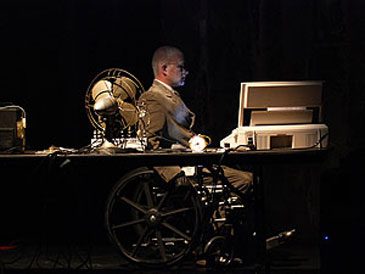Always a Crisis: Politics of Fear at the Casket Factory
Lightsey Darst reviews Skewed Visions' Strange Love at Casket Arts through October 14.

Skewed Visions’ new site-specific work, Strange Love, an exploration of the politics of fear appropriately set in an old casket factory, moves forward in two sections. The “device,” Sean Kelley-Pegg’s creation, is an installation, a maze of black plastic and radiation symbols. It reminds me of nothing so much as Halloween haunted houses, and as such it’s fun. The vicarious thrill of watching my fellow maze-goers as they sit in the “Strange Love” photo booth, unaware that they are being filmed, overwhelms the slight creepiness of having been watched myself. The chair with ankle and wrist irons is chilling, but so literal that I can fend it off; instead of trembling, I have leisure to be amused at the gallery of post-industrial junk assembled in the place of torture implements. Running around in the dark, hearing others around me run around in the dark, I emerge from the nuclear contamination/torture/surveillance labyrinth giggling.
And yet I’m not sure that this reaction isn’t ultimately more creepy than flat-out horror. Having laughed at what’s really not funny, I’m complicit, already drawing my own little profit and peace with the disaster industry. This is brought home by the scene at the end of the device: a war room, with low-slung industrial ceiling, tables angled towards a vacant wheelchair ready for Dr. Strangelove, at which I am to take my seat, a conspirator.
The second section of Strange Love is a performance: Charles Campbell, as a white-faced Strangelovian fearmonger, wheedles and lectures us on preparedness, sometimes attacking, sometimes defending, but always moving over the territory of “something dreadfully wrong there somewhere” in a prickly, creepy, bloody-mouthed, relentless way. He also interacts with the projection screen behind him, on which, between intervals of video collage—the film Dr. Strangelove, the Pentagon channel, etc—a pair of thin and nasty lips appear and utter lines.
It’s all as well-done as one could ask—Campbell’s acting, wunderkind Elliott Durko Lynch’s sound and video—entertaining, with no slow moments—and yet Strange Love is more moving than formally successful. What I mean by this is that the piece has nowhere to go. Situated in no real milieu, with a perpetually shifting viewpoint, Campbell’s character can get nowhere. With the continual barrage of disaster, I began to feel as if I were reading yet another apocalyptic Harper’s article singling out a new root cause for our current crisis (there is always a crisis) as feverishly as some might seek a messiah. Shapeless, the piece is interrupted twice by a guest artist (a different artist each night); after each interruption Campbell winds himself back up and goes on. The eventual ending is a meltdown. But this formal failure is pointed. Much of Campbell’s text is collage: snatches from Dr. Strangelove (“precious bodily fluids”), Beckett, Donald Rumsfeld, etc. He’s working in an already exhausted language—the language of fear, of lies—and so naturally the piece falls apart. Collage gets us nowhere; the circling of fear gets us nowhere; helpless, confused, we simply have to get out of this monologue.
Real feeling is always an opening for criticism. Campbell’s previous two forays into Dr. Strangelove, preparatory work for this piece, were internal, devoid of social mission, impervious to critique by virtue of their total self-involvement. In Strange Love Campbell moves towards now, the present (he invokes terrorists, the Middle East), and a desire for escape and change. This is a gap in Strange Love’s Strange Love to lurch. But it alerts us to our need for a new conversation.